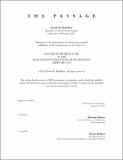| dc.contributor.advisor | Mariana Ibañez. | en_US |
| dc.contributor.author | Bellefleur, Natalie K.(Natalie Karin) | en_US |
| dc.contributor.other | Massachusetts Institute of Technology. Department of Architecture. | en_US |
| dc.date.accessioned | 2019-07-15T20:34:46Z | |
| dc.date.available | 2019-07-15T20:34:46Z | |
| dc.date.copyright | 2019 | en_US |
| dc.date.issued | 2019 | en_US |
| dc.identifier.uri | https://hdl.handle.net/1721.1/121692 | |
| dc.description | This electronic version was submitted by the student author. The certified thesis is available in the Institute Archives and Special Collections. | en_US |
| dc.description | Thesis: M. Arch., Massachusetts Institute of Technology, Department of Architecture, 2019 | en_US |
| dc.description | Cataloged from student-submitted PDF version of thesis. | en_US |
| dc.description | Includes bibliographical references (pages 135-139). | en_US |
| dc.description.abstract | A passage within architectural discourse refers to a narrow space which leads from one place to another. It is the intermediary zone between two defined programmes. It is a moment of transition, where the ambiguity of its claim facilitates for multiple crossings which lead to unexpected interactions and transactions. This thesis explores the current and projected intersection of passages within the context of the Mediterranean Sea. In particular, the intersection between the passage of migrants and that of renewable energy is investigated. The speculation of this thesis is to ask if architecture can aid in producing a platform from which a mutually beneficial relationship can form between that of irregular migrants and the renewable energy sector. Following the peak of irregular migrants crossing by sea in 2015 new policies, which have included the closing of national borders have lead to migrants attempting more dangerous passages. | en_US |
| dc.description.abstract | As a result, fatalities have increased, simultaneously search and rescue responses have become more political in nature. The sea in the eyes of the migrant has become a barrier. In the eyes of renewable energy corporations and policy makers the sea is awaiting harvest. There lies the potential for a hybrid form of infrastructure, one in which a mutually beneficial relationship can exist between the social and technological agendas. The proposal is for a network of energy stations, which provide a physical as well as financial platform for which response to search and rescues may take place. From initial processing, to optional skills training in renewable energies and graduation to a paid year-long field placement, the network is an advocate of connectivity and productivity. With funding from NGO and non profit organizations, units for living can be subsequently brought to site and reinstalled elsewhere as migration and unemployment patterns continue to fluctuate. | en_US |
| dc.description.abstract | In such a way the human scale may find itself within the vast expansion of our technological landscapes. | en_US |
| dc.description.statementofresponsibility | by Natalie K. Bellefleur. | en_US |
| dc.format.extent | 139 pages | en_US |
| dc.language.iso | eng | en_US |
| dc.publisher | Massachusetts Institute of Technology | en_US |
| dc.rights | MIT theses are protected by copyright. They may be viewed, downloaded, or printed from this source but further reproduction or distribution in any format is prohibited without written permission. | en_US |
| dc.rights.uri | http://dspace.mit.edu/handle/1721.1/7582 | en_US |
| dc.subject | Architecture. | en_US |
| dc.title | The passage | en_US |
| dc.type | Thesis | en_US |
| dc.description.degree | M. Arch. | en_US |
| dc.contributor.department | Massachusetts Institute of Technology. Department of Architecture | en_US |
| dc.identifier.oclc | 1102594652 | en_US |
| dc.description.collection | M.Arch. Massachusetts Institute of Technology, Department of Architecture | en_US |
| dspace.imported | 2019-07-15T20:34:42Z | en_US |
| mit.thesis.degree | Master | en_US |
| mit.thesis.department | Arch | en_US |
